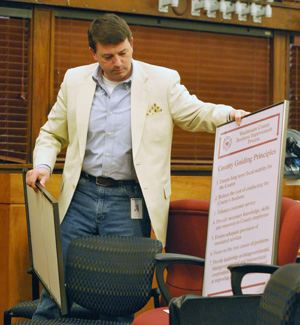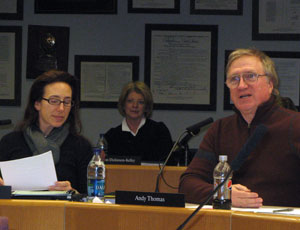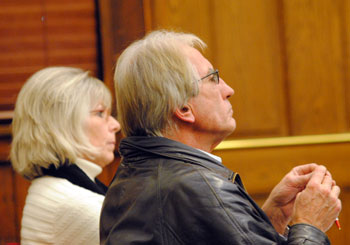A cluster of Community High students standing in the school parking lot, watching the demolition of the burnt-out house at 322 E. Kingsley – another step in the Zingerman’s Deli expansion project. When the backhoe pulls down a section with a crash, the students cheer. [photo] [photo]
Archive for February, 2011
UM: China
Reuters published a guest column by Tom Lyon, director of the University of Michigan Erb Institute for Global Sustainable Enterprise, and Peter Adriaens, a UM professor of entrepreneurship. They explore how the U.S. compares with China in terms of innovation and entrepreneurship, specifically in the context of clean energy research. Noting that President Obama has pushed for the U.S. to outpace China, the writers argue that the call to competition shouldn’t get in the way of collaborative efforts between the two countries. [Source]
Ingalls Mall
St. Valentine’s Candy Ninjas? [photo]
A2: Business
The Eastern Echo publishes an essay by Eastern Michigan University student Neil Weinberg, who reflects on the possibility of Ann Arbor-based Borders Group filing for Chapter 11 bankruptcy. He writes: “It’s pretty irrational to pay 40 percent more in person for something you could get online from the same company, let alone the 60 percent discount their online competitor offers. Financially, it is a dying model. There isn’t really anything we can do to reverse the decline aside from paying drastically more every time we need something new to read. As much as we treasure bookstores, perhaps it’s time to let them go. We shouldn’t be afraid of the coming realignment.” [Source]
County Board Strategizes on 2012-13 Budget
Washtenaw County board of commissioners budget retreat (Feb. 9, 2011): For two hours last Wednesday evening, commissioners continued a discussion on priorities aimed at guiding budget decisions – both long-term and immediate – for county government.

Bill Reynolds, Washtenaw County's deputy administrator, with a framed copy of the county's "guiding principles."
The discussion was another step toward developing a framework that county administrator Verna McDaniel and her staff can use in their budget planning for 2012 and 2013, when the county faces a projected $20.9 million deficit. The session followed a five-hour Jan. 29 retreat. The board also plans to continue their budget talks on Feb. 23, after their regular administrative briefing.
Conan Smith, chair of the board, told the group he hoped they could form an outline of their priorities – not in terms of programs, but at a policy level. He said that focusing on specific programs at this point would limit the administration’s flexibility for future restructuring.
During the two-hour session, commissioners talked about the importance of providing a safety net of services for residents who are most in need – perhaps through a combination of the county’s own services, and partnerships with outside agencies. Though some commissioners expressed concerns about privatizing, there seemed to be consensus about exploring ways to market the county’s infrastructure services – like payroll processing and human resources – to other local municipalities.
They discussed the need for more self-reliance on local resources, as opposed to state and federal funding – while acknowledging the dependence that many county programs have on state and federal grants. The board also talked about the importance of balancing short-term budget needs with long-term investments that could bring more significant structural savings in future years.
Also during Wednesday’s retreat, some commissioners noted the importance of keeping all budget discussions in public view. The retreats – unlike the board’s regular meetings and working sessions – are not televised, though they are open to the public. In addition to county commissioners, the retreats are attended by other elected officials and county staff. [Full Story]
AAPS Set for Six Superintendent Interviews
Ann Arbor Public Schools board of education meeting (Feb. 9, 2011): At its Wednesday meeting, the AAPS board announced six semi-finalists for the district’s open superintendent position. In alphabetical order, the candidates and the school districts in which they are currently working are: William DeFrance (Eaton Rapids Public Schools, Michigan); Patricia Green (North Allegheny School District, Pennsylvania.); Paul Long (Pennsbury School District, Pennsylvania); Michael Muñoz (Des Moines Public Schools, Iowa); Shelley Redinger (Oregon Trail School District, Oregon); and Manuel Rodriguez (Baltimore County Public Schools, Maryland).

Trustee Andy Thomas, makes a point during the AAPS board discussion on interview questions for superintendent candidates. Seated to his right at the board table is trustee Christine Stead. (Photo by the writer.)
Candidate bios and photos, along with detailed information about when and where candidate interviews will be held next week, are available on the AAPS website. The public is invited to attend, but not participate in, this first round of interviews. The board decided on more than 20 questions to be asked during a two-hour interview of each candidate, and plans to select two or three finalists for the position immediate following the last interview on Friday, Feb. 18.
Also at Wednesday’s meeting, Stone High School successfully won board approval to change its name to Ann Arbor Technological High School, and Skyline High School principal Sulura Jackson was honored for being named principal of the year by the Michigan Association of Secondary School Principals. Jackson will now move on to compete nationally. [Full Story]
A2: Arts & Crafts
The Flint Handmade blog features Ann Arbor artisan Kate Kehoe, who sells her wares through her company, Chicaloo. In response to a question about how she came up with the name, Kehoe says: “This was a harder decision than one would think. I discarded a lot of names before deciding on Chicaloo. It is a term of endearment that I call some of my friends. I thought it was appropriate since they are the ones who supported me at the beginning of my crafty career.” [Source]
Little Lake Drive
Great Oak Cohousing: Some of the neighborhood kids built this cool igloo, and at least one of them is sleeping out in it for fun. [photo]
Ann Arbor 2012 Budget: 15th District Court
Editor’s note: The Ann Arbor city council has held two retreats to discuss the city’s FY 2012 budget – one in early December 2010 and another in early January 2011. A summary of the material covered in those retreats is provided in previous Chronicle coverage: “Ann Arbor: Engaging the FY 2012 Budget.”
Leading up to the city administrator’s proposed budget in April, the city council is also holding a series of work sessions on the budget. Their typical scheduling pattern is for the weeks between council meetings. But the work session on the 15th District Court was held just before the council’s Feb. 7, 2011 meeting.

Former city councilmember Chris Easthope was elected in 2008 to serve as a judge on Ann Arbor's 15th District Court. In this photo, Easthope was pointing out other judges, the magistrate and staff of the court, who attended the Feb. 7 work session along with Easthope. (Photo by the writer.)
An hour before the city council’s regular meeting on Feb. 7, 2011, scheduled to start at 7 p.m., councilmembers received a presentation from Chris Easthope on the financial picture for the 15th District Court. The court is funded primarily, but not completely, by the city. Last year, the city’s approved FY 2011 budget for the 15th District Court was $3,776,080, or around 4.5%, of the city’s $81,449,966 general fund budget.
Salaries for the three judges on the court – Easthope, Julie Creal and Elizabeth Hines – are set and paid by the state of Michigan. The judges, along with other key court staff, also attended the work session.
Easthope stressed to councilmembers that he understood the difficult position the council is in, having served on the city council himself. [First elected in 2000 to a Ward 5 seat on the city council, Easthope won a narrow victory in the 2008 race for the 15th District Court judgeship.]
The basic picture Easthope sketched out for the council was of a court that had already reduced its budget – from $4.1 million in FY 2008 to $3.8 million in FY 2011, the current fiscal year. Easthope estimated the needed budget for the court in the next two years at around $3.7 million.
Measures already implemented include optimization of staffing that has allowed a reduction in full-time employees from 40 FTEs four years ago to 32 FTEs today. Easthope also stressed that the court’s probation program, even though it is not mandated by the state, actually saves citizens money, because it offers an alternative to fines (which many defendants aren’t in a financial position to pay anyway) and jail (which may not be the best solution for mentally ill defendants). [Full Story]
Ashley & Liberty
Valentine’s Day origami dove with heart in beak graces Old Town Tavern. Best Valentine’s Day beer: Bell’s Two Hearted Ale. [photo]
Crisler Arena
Gov. Rick Snyder shaking hands with Maize Rage students at Michigan basketball game.
State & Washington
The wraps have come off CVS on North State. [photo]
Coler & Packard
The tide of the war against pedestrian island swings back toward cars. [photo]
A2: Redistricting Study
An editorial in the Detroit Free Press highlights a recent study by the Ann Arbor-based Center for Michigan, which found that the way districts are drawn for the state legislature often pre-determines election outcomes along party lines: “According to the Center for Michigan study, Republicans have had a hammerlock on 43 House seats and 19 Senate seats for at least the last decade; Democrats have monopolized 42 House seats and 11 Senate seats during the same interval. As a result, only one in seven Michigan voters lives in a district where either party’s candidates could prevail in any given election cycle.” [Source]
UM: Sigma Alpha Epsilon
The Detroit Free Press reports that the Sigma Alpha Epsilon fraternity at the University of Michigan has been suspended for alleged hazing. The suspension came after one parent of a pledge wrote to the university about physical abuse, insults, drinking, and humiliation that pledges had to endure as part of a hazing process. On Wednesday, the SAE chapter was suspended from any other Greek event at UM and, not long after, the national headquarters of SAE suspended the chapter indefinitely, according to the report. [Source]
A2: Business
The Wall Street Journal reports that Ann Arbor-based Borders Group is close to filing for Chapter 11 bankruptcy protection, possibly on Monday or Tuesday. Quoting unidentified sources familiar with the matter, the report states that the bookstore chain initially plans to close about 200 of its 674 stores: “Liquidators have been bidding for the right to run the store closures, with an option to close an additional 50 stores or so under similar terms.” [Source]
UM Diag
Circle of people singing, waving Egyptian flags, and handing out candy to celebrate Mubarak’s resignation.
Washtenaw: Suffragists
“Liberty Awakes” – an exhibit about the local suffrage movement – is running through Feb. 27, 2011 at The Museum on Main Street, 500 N. Main, Ann Arbor. The exhibit includes original and replica artifacts and memorabilia documenting efforts of local women to secure the vote, and describes how they were involved in the broader state and national suffrage movement. The exhibit was organized by the League of Women Voters of the Ann Arbor Area, and co-curated by Zoe Behnke and Jeanine DeLay. [Source]
Greenbelt Gets Mid-Year Financial Review
Ann Arbor Greenbelt Advisory Commission meeting (Feb. 9, 2011): The main event of the commission’s Wednesday meeting was a review of the second-quarter financial picture. The review was presented by Ginny Trocchio, who works for The Conservation Fund, a consultant the city employs to assist with administering the greenbelt millage. Highlights of the presentation included the calculation of administrative overhead costs – including The Conservation Fund’s work – which are well below the legal maximum of 6%.

Blobs inside the squarish boundaries represent properties or development rights acquired with greenbelt millage funds. The darker squarish area is the original area where millage funds could be spent. The lighter strips to the east, south, and west were added in 2007. (Image links to higher resolution file.)
Though not included explicitly in the millage language, the city approaches the administration of the millage as a one-third/two-thirds split between a portion for parks and a portion for the greenbelt program. So as part of the financial review, commissioners also looked at current fund balances as analyzed based on the one-third/two-third split between parks and greenbelt projects. Noting that the greenbelt fund balance might be on track to be drawn down before the parks portion is exhausted, commissioners seemed to agree that now is a good time to begin mulling what should happen if that scenario played out. The group discussed holding a joint meeting between the park and greenbelt advisory commissions – their last joint session was held in April 2010.
Also discussed on Wednesday was the scheduling of a first meeting of a commission subcommittee that will look at the question of changing greenbelt boundaries. The boundaries define the region where land or development rights on land might be acquired by the greenbelt program. Any change to those boundaries would ultimately require approval from the Ann Arbor city council. [Full Story]
Column: Super-Hyped Super Bowl
Forty-five years ago, the Super Bowl … wasn’t even the Super Bowl. They called it the NFL-AFL Championship Game, until one of the founders renamed it after watching his grandson play with a “High Bouncing Ball” – a super ball. Super ball – Super Bowl. Get it? And thus, an artificial event was born.
Tickets were just fifteen bucks for that first game – and they barely sold half of those, leaving some 40,000 empty seats in the Los Angeles Coliseum.
A 30-second ad cost only $42,000 – and they weren’t any different than the ads they showed the previous weekend. The half-time show featured three college marching bands – including one you might have seen from the University of Michigan.
Over the next couple decades, of course, the event became a veritable national holiday. Tickets now sell for thousands of dollars, and ads for millions. The game attracts more than 100 million viewers in the U.S. alone. [Full Story]
A2: Home Values
A CBS MoneyWatch report by Ilyce Glink looks at U.S. cities with the highest year-over-year gains in home values – Ann Arbor, with an 11.3% gain, ranks first. From the report: “In Ann Arbor, Michigan and other top college towns, home values have held up better than in many other locations. Ann Arbor is the seat of the University of Michigan. Demand has stayed strong for that University, so it makes sense to me that housing demand has stayed strong as well.” [Source]
AAPS Board: Six Superintendent Finalists
At its Feb. 9, 2011 meeting, the Ann Arbor Public Schools board of education announced six semi-finalists for the district’s open superintendent position. In alphabetical order, the candidates and the school districts in which they are currently working are: William DeFrance (Eaton Rapids Public Schools, Michigan); Patricia Green (North Allegheny School District, Pennsylvania.); Paul Long (Pennsbury School District, Pennsylvania); Michael Munoz (Des Moines Public Schools, Iowa); Shelley Redinger (Oregon Trail School District, Oregon); and Manuel Rodriguez (Baltimore County Public Schools, Maryland).
Board members also set interview questions and blocked out times to hold the first round of open interviews next week. This brief was filed shortly after the board’s meeting. A more detailed report of last night’s meeting will follow: [link] [Full Story]
Planning Commission Postpones Parks Plan
Ann Arbor planning commission meeting (Feb. 8, 2011): After 90 minutes that included public commentary from three board members of the Allen Creek Greenway Conservancy, planning commissioners voted to postpone action on the city’s Parks and Recreation Open Space (PROS) plan until their Feb. 15 meeting.

Ray Fullerton, a board member of the Allen Creek Greenway Conservancy, passes out a letter to planning commissioners that makes suggestions for revising the city's Parks and Recreation Open Space (PROS) plan. In the background is planning commissioner Kirk Westphal. (Photos by the writer.)
The postponement coordinated with a similar move made last month by the Ann Arbor park advisory commission, which rescheduled its vote to its Feb. 15 meeting in order to allow for additional public input.
The PROS plan provides an inventory, needs assessment and action plan for the city’s parks system, and is updated every five years. The updated document is required by the state in order for the city to be eligible to apply for certain grants.
A public hearing on the PROS plan drew three board members of the Allen Creek Greenway Conservancy, a nonprofit dedicated to developing a park running through Ann Arbor from Stadium Boulevard to the Huron River, roughly following the course of the original Allen Creek. They advocated for stronger support of the greenway within the PROS plan. [Full Story]
Marijuana Law Stalls; Future Projects OK’d
Ann Arbor City Council meeting (Feb. 7, 2011): At its Monday meeting, the council made some progress on further amendments to a proposed licensing scheme for medical marijuana businesses, but ultimately decided to postpone their initial vote on the licensing law. Among the amendments made by the council on Monday night was one that provided a definition of a “cultivation facility” – something that a council caucus attendee had suggested the night before.
The postponement of an initial vote to the council’s next meeting, on Feb. 21 22, means that a final vote on licensing could not come sooner than the council’s March 7 meeting. An initial vote on zoning regulations for medical marijuana businesses was already taken by the council at its Oct. 18, 2010 meeting. On Monday, the final vote on those zoning regulations was also postponed to March 7. The council’s pattern over the last two months has been to postpone the final vote on zoning regulations for medical marijuana businesses so that it will coincide with the final vote on licensing.

Betsy and Alex de Parry listen as councilmembers deliberate the question of whether to grant a fee waiver if de Parry resubmits his Heritage Row project to the city. (Photos by the writer.)
The council also took action on several development-related issues. Without discussion, councilmembers approved an amendment to a contract with Village Green to develop a 244-space parking deck as the first two stories of a 9-story building, City Apartments – a 156-unit residential planned unit development (PUD) at First and Washington. The contract approval is part of a series of milestones that is planned to culminate in Village Green’s purchase of the city-owned land parcel for $3 million by June 1, 2011, and with construction starting later in the summer.
The council also approved an application fee reduction, from nearly $5,000 to $2,000, for the developer of Heritage Row, a residential project proposed for Fifth Avenue just south of William Street – if the project is resubmitted within 90 days. The resolution began as a fee waiver, but was amended to be a reduction. On resubmission, the project will go through the complete review process, starting with a citizen participation meeting.
The council also took action to implement the city’s new design guidelines for new downtown buildings. It sets a purely voluntary review and compliance process in place for now, with the expectation that the mandatory review process with voluntary compliance will be implemented later.
The council unanimously approved the city’s new capital improvements plan (CIP) after a close 6-5 vote that removed an item calling for an extension to the Ann Arbor municipal airport runway. And one item appearing in the CIP was moved ahead to possible fruition: A possible roundabout for the Maiden Lane and Fuller Road intersection will be studied and engineered under a $460,139 contract with DLZ Michigan Inc.
At Monday’s meeting, the council also authorized applications for federal matching funds to acquire development rights for two greenbelt properties.
And labor issues found their way into the deliberations in two ways. First, Stephen Rapundalo (Ward 2), chair of the council’s labor committee, gave a breakdown of the large disparity between health care costs paid by the city’s fire and police union members as contrasted with the city’s non-union staff, as well as with University of Michigan employees. Second, as part of its consent agenda, the council approved a $54,000 contract with a consultant to study fire protection service requirements in Ann Arbor. The city administrator cited such a study at a recent council budget retreat as useful if the city decides to contemplate a shift to a combined paid-on-call and full-time staff fire department. [Full Story]
A2: Business
The local retailer 16 Hands has emailed its customers to announce that the downtown Ann Arbor store, at 216 S. Main, will be moving later this year: “Some huge changes are in the works at 16 Hands, and we wanted our customers to be the first to know. Our lease is up at the end of July, and we’ve decided not to renew it. But fear not, loyal 16 Hands friends, we’ll still be in Ann Arbor and online. We’ll be moving and shifting our focus a bit, but for now we have to keep you in suspense on the details. What we CAN tell you is that in our new location, we’ll be carrying even more cool jewelry … [Full Story]
Third & Liberty
Woman struggling to get a baby stroller over a mound of snow at the intersection’s sidewalk.
East Liberty
Say it ain’t so … Carmen, the Encore Records shop dog, has died. [photo]
Ann Arbor OKs Village Green Contract
At its Feb. 7, 2011 meeting, the Ann Arbor city council approved an amendment to a contract with Village Green to develop a 244-space parking deck as the first two stories of a 9-story, 99-foot-tall building, City Apartments – a 156-unit residential planned unit development (PUD) at First and Washington. Among other items, the amendment clarifies the ability of the Ann Arbor Downtown Development Authority and the city to provide oversight to the construction process.
Once the parking deck portion of the building is completed and issued a certificate of occupancy, the city of Ann Arbor has agreed to issue $9 million worth of bonds to purchase the deck, and the Ann Arbor DDA has agreed to make the payments on those bonds. The DDA board approved its part of the contract amendment at its Feb. 2, 2011 meeting.
The contract amendment comes in the context of a series of milestones that were put in place last year, when the council extended Village Green’s option to purchase the parcel at First and Washington, where City Apartments would be built. That most recent extension came at the the council’s Aug. 5, 2010 meeting, and provides a purchase option through June 1, 2011. The $3 million from the transaction would be put towards the construction fund for the city’s new municipal center, which is now largely complete and partly open for business. If the $3 million transaction does not go through, the city has said it would borrow money to cover the construction shortfall, a step that would require city council approval.
This brief was filed from the boardroom in the Washtenaw County administration building, where the council is meeting due to renovations in the city hall building. A more detailed report will follow: [link] [Full Story]
Fuller-Maiden Lane Intersection Gets Study
At its Feb. 7, 2011 meeting, the Ann Arbor city council authorized a $460,139 contract with DLZ Michigan Inc. to review previous studies of the Fuller Road/Maiden Lane/East Medical Center Drive intersection and propose a design for a reconfiguration of the intersection. Previous studies point to a roundabout as a good solution to the traffic congestion at the intersection. The poor level of service (LOS) in that area has prompted the city to propose various solutions to the intersection redesign, dating back at least to 2005. Depending on the time of day, the intersection currently rates D and E on the letter-grade scale used to evaluate traffic flow.
In the city’s capital improvements plan (CIP), the intersection improvement is categorized with bridge projects – it’s immediately adjacent to the Maiden Lane bridge over the Huron River.
In 2009, the city studied the intersection in the context of increased traffic load due to possible construction of the Fuller Road Station – an intermodal transit center and parking deck proposed for the area between Fuller Road and East Medical Center Drive. The city’s online meeting packet includes drawings of the current configuration of the intersection as well as the possible roundabout configuration.
The engineering and design of the roundabout project will be funded out of the FY 2011 capital budget for the city’s street reconstruction millage. Construction is expected to be funded out of a combination of: (1) millage revenues in future years; (2) possible funds from a federal Congestion Mitigation Air Quality (CMAQ) grant; and (3) a contribution from the University of Michigan.
In a telephone interview Monday morning before the evening council meeting, Homayoon Pirooz, in the city’s project management unit, told The Chronicle that construction on any project would not begin before the summer of 2012, with 2013 a more likely timeframe. Pirooz ballparked the construction cost of a project like this – once all the traffic lanes leading to the intersection are modified, and the pedestrian amenities are installed – as possibly more than $2.5 million.
This brief was filed from the boardroom in the Washtenaw County administration building, where the council is meeting due to renovations in the city hall building. A more detailed report will follow: [link] [Full Story]
Ann Arbor Council Approves Capital Plan
At its Feb. 7, 2011 meeting, the Ann Arbor city council approved its capital improvements plan (CIP). The plan covers the fiscal years 2012-2017, and includes a list of major capital projects – for projects that have identified funding sources as well as those that do not. The city code requires that the CIP be developed and updated each year, looking ahead at a six-year period, to help with financial planning. It’s intended to reflect the city’s priorities and needs, and serves as a guide to discern what projects are on the horizon.
Included in this year’s proposed CIP was a plan for a runway extension at the city’s municipal airport, an item that the council had voted to remove last year before last year’s CIP was finally adopted. This year, Stephen Kunselman (Ward 3) raised the same objection about the runway that he had voiced the previous year, and the council again removed the item by a narrow 6-5 vote.
The city’s planning commission recommended adoption of the CIP at its Jan. 4, 2011 meeting, when commissioners discussed in detail how the plan was developed and how public input was sought. [Previous Chronicle coverage of the possible airport runway extension: "Ann Arbor Airport Study Gets Public Hearing"]
This brief was filed from the boardroom in the Washtenaw County administration building, where the council is meeting due to renovations in the city hall building. A more detailed report will follow: [link] [Full Story]




